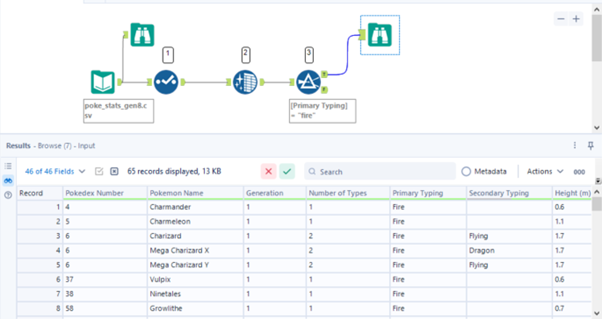26 Jul 23
Alteryx, Explained: When (and How) I Use This Platform
Alteryx, released in 2006, is a very powerful piece of software. It can be used for a wide variety of data tasks from advanced data analytics to extract, transform, and load (ETL) and even data science, facilitated by an easy-to-use drag-and-drop system.
For those of you familiar with Scratch, which is how I learned to program (over 10 years ago!), Alteryx feels very familiar as a data equivalent, because you drag blocks from the Tool Palette and connect them together as you would on Scratch, and both platforms are no-code/low-code, which means you don’t have to know any programming languages to use it.
However, while Alteryx shares some similarities with Scratch, the possibilities in Alteryx far surpass what you can accomplish in Scratch. The highest-end games and projects in Scratch, such as a port of Geometry Dash, require significant existing knowledge of creating game engines, and Scratch is more intended for learning to code, whereas Alteryx has nearly endless possibilities for data practitioners across all skill levels, whilst still maintaining the intuitiveness of the drop-and-drop system.
Alteryx’s incredible capability is highlighted in Gartner’s Magic Quadrant report, where the program has retained a spot in the report’s “Leaders Quadrant” for many years.
Using Alteryx to Clean a Dataset
Here is an example of how Alteryx can be used to help clean up a dataset and filter out irrelevant information. Shown in the image below is a simple workflow, in which I bring in some data about various Pokémon.

The tool with the green binoculars allows you to view the data, and the above screenshot shows the data as it stands, and we can see that there is some data we might not need, such as ‘Field_1’. As data cleaning is an important factor in any data-related process, we use the Select, Data Cleaning, and Filter tools, labelled as 1, 2 and 3 respectively in the image above.
The Select tool is a very powerful tool that lets you rename columns, change data types and inspect all of the columns you have available. In this case, I went ahead and removed Field_1, the status column, and the German and Japanese names, and also re-named the other columns to be more informative.
Secondly, the Data Cleaning tool can be used to remove any null values, or even replace them with blanks, all through a simple GUI (there is another tool that allows you to replace any certain records with something else, called the Formula tool). Lastly, the Filter tool allows you to filter based on conditions, and in this case, I just wanted to see Fire-type Pokémon, which is handily added as a caption automatically underneath the tool. Now that we’ve performed these steps, we are left with this:

As you can see, we are just left with the Fire-type Pokémon, the column names are more meaningful and the null values that were present in secondary typing have been removed. All by using just five different tools, in less than five minutes!
Why Did I Start Using Alteryx?
The first time I used Alteryx was whilst working on a project with an external client, who had little experience with coding, and as such my group and I adopted the use of Alteryx, in line with our client’s current software stack.
As I had never actually heard of the program before the project brief, I downloaded it and got stuck in to get a feel for the program before the project started, and I was immediately impressed by the intuitiveness of the program. My usual approach is to watch videos or read relevant documentation before getting started, but this was totally unnecessary as I got the hang of it rather quickly.
After a few hours of exploring its features, I decided to go straight in and try out one of Alteryx’s certifications and managed to complete it first try. Which is to say ―for those with foundational data skills, learning Alteryx is relatively easy.
Why Not Just Use Python?
The short answer is―I still use Python, but Alteryx is a great tool to use when you’re working with cross-functional teams that include non-data professionals.
I was fortunate enough to have the experience in Python, but the stakeholder of our project did not, and as such the accessibility of Alteryx really came in handy.
As I demonstrated above, I could very quickly drag some tools onto the canvas and perform some transformations very quickly, making it excellent for proof of concepts before loading Python and writing out the code myself.
Alteryx’s Input Data tool where you import your data is akin to the read_csv function within Pandas, and even allows you to browse your computer’s directory rather than typing out an often lengthy file path into your IDE!
The Input Data tool is far more flexible than simply reading in .csv files, offering a wide selection of supported file types and even importing from other data sources, such as a cloud database or even Microsoft OneDrive. As an avid programmer myself, I should mention that I use Python regularly and find it an extremely useful tool. However, I do think that Alteryx’s easy-to-use nature makes it a fantastic program, especially for newer programmers.
How to Get Started in Alteryx
If you’re interested in trying out the platform but don’t know how to get started, definitely check out Alteryx’s online community where users can pose questions if they get stuck, much like Stack Overflow. You can also upload your own workflows or view others’ to get a feel for the kind of projects you can carry out.
Another great aspect of the community is the learning resources available, from learning paths to weekly challenges (with solutions) to test your knowledge.
If you really want to test your knowledge, however, there are a range of accreditations available, from micro-credentials for specialist areas such as Data Preparation, as well as more difficult exams that test many various aspects of the program, which you can display on your LinkedIn profile to show off your skills.
Alteryx can be downloaded with a free one-month trial at https://www.alteryx.com/.
Interested in joining our diverse team? Find out more about the Rockborne graduate programme here.
Related posts
Life at Rockborne20 Jun 25
Federated Learning: The Future of Collaborative AI in Action
Federated Learning: The Future of Collaborative AI in Action The way we build, deploy, and govern AI is evolving, and so are the expectations placed on organisations to do this...
09 Sep 24
Tips to Succeed in Data Without a STEM Degree
By Farah Hussain I graduated in Politics with French, ventured into retail management, dabbled in entrepreneurship, a mini course in SQL and now… I am a Data Consultant at Rockborne....
15 Apr 24
Game Development at Rockborne: How is Python Used?
Just how is Python used in game development? In this blog post, we see the Rockborne consultants put their theory into practice. As the final project in their Python Basics...

